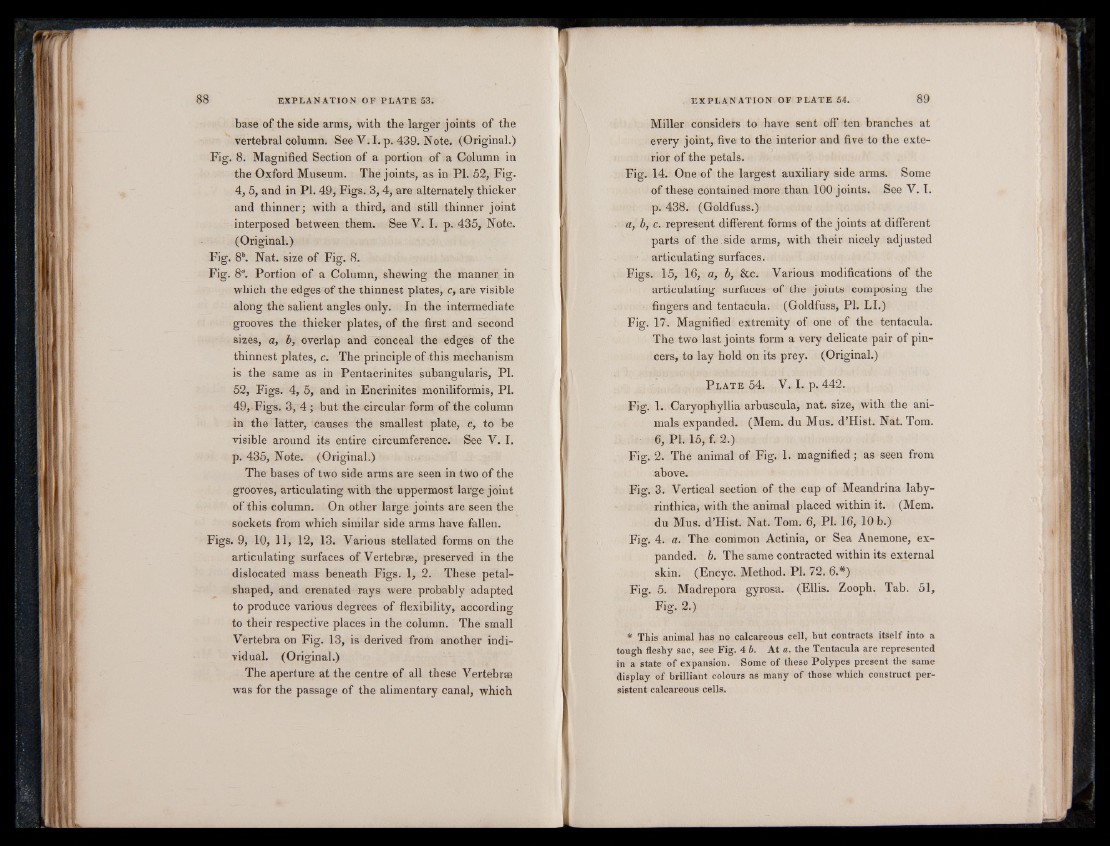
base of the side arms, with the larger joints of the
vertebral column. See V. I. p. 439. Note. (Original.)
Fig. 8. Magnified Section of a portion of a Column in
the Oxford Museum. The joints, as in PI. 52, Fig.
4, 5, and in PI. 49, Figs. 3, 4, are alternately thicker
and thinner; with a third, and still thinner joint
interposed between them. See V. I. p. 435, Note.
(Original.)
Fig. 8b. Nat. size of Fig. 8.
Fig. 8“. Portion of a Column, shewing the manner in
which the edges of the thinnest plates, c, are visible
along the salient angles only. In the intermediate
grooves the thicker plates, of the first and second
sizes, a, b, overlap and conceal the edges of the
thinnest plates, c. The principle of this mechanism
is the same as in Pentacrinites subangularis, PI.
52, Figs. 4, 5, and in Encrinites moniliformis, PL
49, Figs. 3, 4 ; but the circular form of the column
in the latter, causes the smallest plate, c, to be
visible around its entire circumference. See V. I.
p. 435, Note. (Original.)
The bases of two side arms are seen in two of the
grooves, articulating with the uppermost large joint
of this column. On other large joints are seen the
sockets from which similar side arms have fallen.
Figs. 9, 10, 11, 12, 13. Various stellated forms on the
articulating surfaces of Vertebrae, preserved in the
dislocated mass beneath Figs. 1, 2. These petalshaped,
and crenated rays were probably adapted
to produce various degrees of flexibility, according
to their respective places in the column. The small
Vertebra on Fig. 13, is derived from another individual.
(Original.)
The aperture at the centre of all these Vertebrae
was for the passage of the alimentary canal, which
Miller considers to have sent off ten branches at
every joint, five to the interior and five to the exterior
of the petals.
Fig. 14. One of the largest auxiliary side arms. Some
of these contained more than 100 joints. See V. I.
p. 438. (Goldfuss.)
a, b, c. represent different forms of the joints at different
parts of the.side arms, with their nicely adjusted
articulating surfaces.
Figs. 15, 16, a, b, See. Various modifications of the
articulating surfaces of the joints composing the
fingers and tentacula. (Goldfuss, PI. LI.)
Fig. 17. Magnified extremity of one of the tentacula.
The two last joints form a very delicate pair of pincers,
to lay hold on its prey. (Original.)
P late 54. V. I. p. 442.
Fig. 1. Caryophyllia arbuscula, nat. size, with the animals
expanded. (Mem. du Mus. d’Hist. Nat. Tom.
6, PI. 15, f. 2.)
Fig. 2. The animal of Fig. 1. magnified; as seen from
above.
Fig. 3. Vertical section of the cup of Meandrina laby-
rinthica, with the animal placed within it. (Mem.
du Mus. d’Hist. Nat. Tom. 6, PI. 16, 10 b.)
Fig. 4. a. The common Actinia, or Sea Anemone, expanded.
b. The same contracted within its external
skin. (Encyc. Method. PI. 72. 6.#)
Fig. 5. Madrepora gyrosa. (Ellis. Zooph. Tab. 51,
Fig. 2.)
* This animal has no calcareous cell, but contracts itself into a
tough fleshy sac, see Fig. 4 b. At a. the Tentacula are represented
in a state of expansion. Some of these Polypes present the same
display of brilliant colours as many of those which construct persistent
calcareous cells.